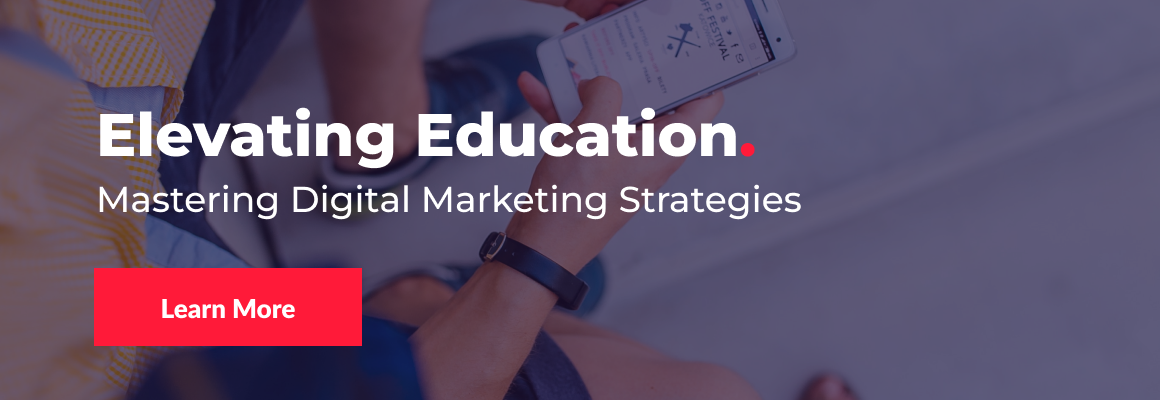5 Reasons Why Your Higher Education Website Isn't Working
Redesigning your higher education institution’s website is a huge decision influenced by a variety of factors. Perhaps your IT team is fed up with the continuous content creation and site manipulation demands from the communications department. Contrarily, the communications team might be losing patience with IT due to delays in implementing their website requests. Or quite possibly, your site was built five years ago, it lacks modern web design best practices, and the content and navigation is completely out of sync with the needs of your current and prospective students.
Regardless of which scenario, embarking on a complete redesign is the biggest digital decision your school can make, given the incredible amount of resources it takes from your university's web and marketing team.
Consider these five signs to help you make a more informed decision when contemplating undergoing a redesign.
1. Your Analytics Say So
Paying close attention to your website's analytics is essential for understanding user behavior and engagement. By focusing on the right metrics, you can gain valuable insights into how visitors interact with your site, revealing patterns and areas that may need improvement. Analyzing this data not only highlights user preferences and pain points but also guides informed decisions on when a website makeover is necessary to enhance functionality and user experience.
Assuming you have Google Analytics setup on your institution's website, here are some key metrics to look for:
- Conversion rate. Are you hitting your goals? Is your website boosting your conversions or holding them back? Take a look at how well your website is performing by analyzing the amount of leads and conversions you're seeing come through the site.
Are you getting enough traffic? Is that traffic qualified? Are the prospective students that are coming to your site reaching your contact/conversion page? Be sure to look at the path to conversion and see where the biggest drop-off is occurring. You might be surprised to see that specific content or certain pages on your site are detracting visitors from actually converting. - Bounce rate. Analyzing your bounce rate will help you answer the question, "Are my prospective students interested and engaged with the content that we have on our website?” Bounce rate refers to the percentage of visitors who arrive at your website and leave without clicking on anything else or viewing additional content. In other words, if they are bouncing, they’re not doing what you want them to be doing.
The lower the bounce rate the better. You can have a high bounce rate for a number of reasons, but the biggest contributing factors are poor content, bad user experience, unclear messaging, or just simply, the landing page is not what the user was expecting. - Website traffic. First, look at your conversion rate and then your traffic. Are you getting enough traffic to be able to reach your lead generation goals? Is it the right traffic that you’re attracting? Are they coming from the right place? Are they landing on the right page? Examine all your traffic metrics comprehensively and consider why you're not receiving enough traffic, why you're attracting the wrong audience, and why visitors aren't taking the desired actions on your site.
This strategic approach ensures that any updates or redesigns are driven by actual user data, ultimately leading to a more effective and engaging online presence. A data-driven approach allows businesses to create a website that resonates with their audience, leading to increased engagement and conversions. Ultimately, this results in a more dynamic and responsive online presence, fostering greater customer satisfaction and loyalty by addressing their needs more effectively.

2. It’s Not Mobile Friendly
Your website might be visually stunning and convert well, but is it responsive? If a considerable amount of traffic to your website comes from a mobile device and you don’t have a responsive design or mobile content strategy in place, you’re missing out on a significant chunk of your potential conversions.
Look at your mobile conversion rate. If you don’t have a responsive website, it will likely be close to 0%. Traffic from mobile devices can be unpredictable, as users tend to be impatient and highly goal-oriented. A user might be seeking anything from quick access to contact details, an event location, a contact form, or a professor's office hours and phone number. If your site doesn’t cater to mobile users then they’re going to bounce.
Again, check your bounce rate specifically for mobile traffic. If it’s high, it’s a sign that your current website is not adequately set up to handle mobile traffic and you should look to create a new responsive digital experience for your visitors.
3. Updating Your Site is a Daily Struggle
Maintaining an outdated website can often feel like an uphill battle, especially if your team finds themselves entrenched in the repetitive task of copying and pasting content. This approach not only drains valuable time but also hampers innovation. How swiftly can your marketing team launch new promotional sites or landing pages? If the answer involves delays and complex processes, it’s a clear indicator that your current system may be holding you back.
Upgrading to a modern content management system (CMS) could transform your workflow. By streamlining content updates and automating routine tasks, a new CMS empowers your team to focus on crafting compelling content and executing dynamic campaigns.
Embrace the opportunity to elevate your digital presence and drive productivity with an open-source content management system (CMS) like Drupal. Drupal is free and publicly accessible, aligning with higher education institutions' commitment to open information sharing. It also offers the flexibility needed for customization.
Don't let outdated technology limit your potential—consider the significant advantages a modern CMS can offer in propelling your higher ed institution forward.

4. You Didn’t Design With Your Students In Mind
It's fair to say that prospective students don't think like university professors, right? They've never developed a course outline or curriculum, nor do they organize university programs or design a school's organizational structure. So why do most schools have a navigation and information architecture that mirrors their existing organizational structure instead of aligning with the expectations of prospective students?
Oftentimes a student wants easy access to quick facts, entrance requirements or a course list. But more often than not that information is about 6-8 clicks from the home page and can be missed entirely. If your information architecture reflects your school's structure more than it does your target audience, it might be time to redesign.
A cumbersome experience can frustrate prospective students, leading them to leave the site before accessing crucial registration details and potentially opting for another institution that offers a clearer, more user-friendly experience.
5. Grandfathered Content Strategy
If any of these situations resonate with you, it might be time to consider a redesign, particularly focusing on content:
- You manage over 600 websites, each built on various platforms and CMSs.
- Your content has been transferred from the previous site without a comprehensive audit.
- Different departments are launching new sites daily without a consistent quality assurance process.
These issues contribute to a digital environment where content is not user-friendly, is challenging to find, or exists in duplicate forms with inconsistent structures. Such problems can lead to Google penalizing your site's rankings, making it harder for prospective students and other users to discover your offerings.
Redesigning with a focus on content can streamline your digital presence, ensuring that information is up-to-date, relevant, and accessible. A cohesive strategy can enhance user experience, improve search engine rankings, and ultimately strengthen your institution's reputation online.
A higher education website redesign is not just about updating aesthetics; it's a strategic move to meet the evolving needs of your institution and its users. Recognizing the signs—like outdated technology, poor mobile responsiveness, and content that doesn't align with student expectations—is crucial in maintaining a competitive edge.
There’s a lot that goes into web performance and optimization, and though this guide may only scratch the surface, we hope that it will open up and spark conversation among your internal teams. If you’d like to have our experts weigh in and help with your website audits, we'd be thrilled to help out. Let’s chat.







